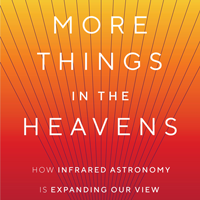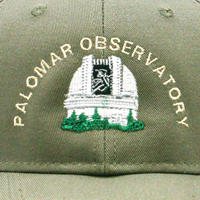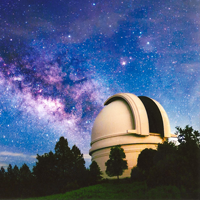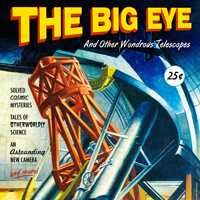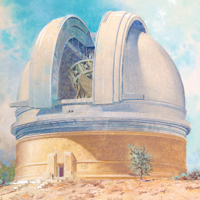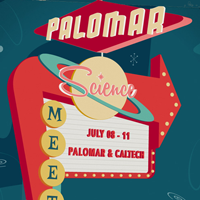Friends of Palomar Observatory Website
Upcoming Events

The Newsletter of the Friends of Palomar Observatory, Vol. 12 No. 2 – June 2017
LIGO, Gravitational Waves, and a New Window on the Universe
By Steve Flanders
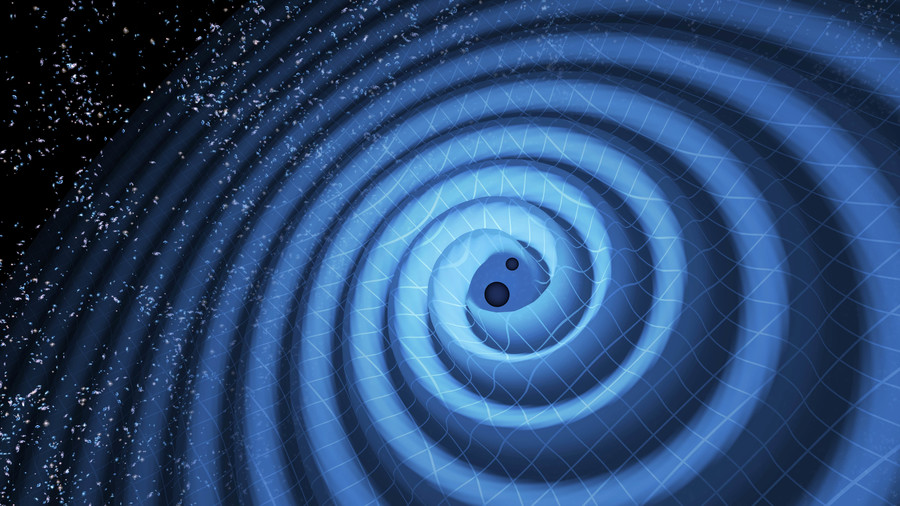
Gravitational waves are generated by the acceleration of a massive body through space-time. The waves dissipate the energy of the acceleration and, in a binary black hole system, that loss of energy causes the two objects gain increased speeds as they are drawn toward each other. The faster they go, the greater rate at which the system loses energy through gravitational radiation. (LIGO/T.Pyle)
For most of history, electromagnetic radiation has provided our primary window upon the distant Universe. Until relatively recently, our view into deep space relied upon radiation coming to the Earth in the narrow frequency band of visible light. Of course, the electromagnetic spectrum extends far beyond this limited range both on the high frequency side and on the low frequency side. As it turns out, with the growth of modern science and modern technologies, we have become quite adept at opening windows to the Universe spanning virtually the entire spectrum of energies and frequencies. Starting with the near infrared in the late 19th century and moving to the radio spectrum, we now have instruments and techniques that allow us to observe most of the energetic activities that take place around us.
But to continue the progress we have made, we now need to step outside the electromagnetic spectrum and open a new and much-anticipated window on the high-energy Universe. Predicted in General Relativity, gravitational waves are generated when masses accelerate and have been described as “ripples in the fabric of space-time.” Originating with the mergers of binary black holes, in neutron stars and pulsars and perhaps in the Big Bang itself, these ripples propagate as gravitational radiation. Generated in the most violent events imaginable, ripples contain information about their origins and about gravity itself, information that cannot be obtained from within the electromagnetic spectrum.
Now the Advanced Laser Interferometer Gravitational-wave Observatory (LIGO or aLIGO) has made three observations of gravitational waves that originated in the merger of binary black holes 1.3 to 3 billion light-years away. Responsible for the design and construction, Caltech and MIT have come together to form a collaboration under which the two institutions now jointly operate the facility with grants from the National Science Foundation.
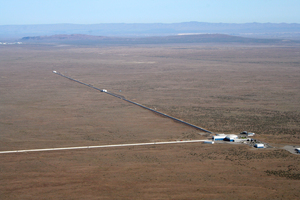
LIGO Hanford. Two arms go off at right angles from the control station. Ultra-high vacuums are maintained in tunnels located in the arms. Precisely positioned mirrors at the end of each tunnel reflect laser light sent from a beam splitter at the vertex. The length of the light beam is exactly the same in each arm. (Caltech/MIT/LIGO Lab)
At present, LIGO consists of two nearly identical observing stations, one in Hanford, Washington, the other in Livingston, Louisiana. At each, two 2.5 mile-long ultra-high vacuum tunnels emerge at right angles from a central control facility where a special mirror splits a beam of laser light sending identical beams down each arm. These ricochet off of mirrors at both ends until, after 400 trips up and down the tubes, the beams are finally recombined near the source and passed to a photodiode detector.
Designed to make use of the wave nature of light, the beam splitter is tuned in such a way that, when they are combined, the two light beams are kept out of phase. As a result, under normal circumstances, no light arrives at the detector. But as they pass by, gravitational waves stretch local space-time in one direction and squeeze it in a perpendicular direction. One arm of the interferometer is lengthened, the other is shortened and, for a brief moment, the laser beam in the shorter arm returns to the beam splitter ahead of the beam in the longer arm. The beam wavefronts, therefore, shift in and out of phase as they merge and varying patterns of constructive and destructive interference are passed to the photodetector.
However, gravitational waves produce only tiny alterations in the lengths of the interferometer's two light paths. In fact, the physical impact of these events in space-time is so slight that no gravitational waves were detected during the first phases of LIGO's operations beginning in 2002. Recently, however, the LIGO Scientific Collaboration completed a $200-million overhaul of its two observatories. The engineers and scientists who collaborated on this work achieved a remarkable level of precision. Each LIGO interferometer is now able to detect a wave-induced difference in the length of its light paths of a little as 5/1,000th the diameter of a proton.

A comparison of the gravitational waves detected by Hanford and Livingston during the GW150914 event. Streaming from a location 1.3 billion light-years away, the two signals became clear and strong and uniform as the merger of the black holes reached its conclusion. The seven millisecond difference in arrival times allowed researchers localize the event to a 150 square degree arc of sky approximately in the direction of the southern constellations Dorado and Mensa. (LIGO)
With this four-fold increase in sensitivity, Advanced LIGO was nearing the end of its last engineering run when on September 14, 2015 Hanford and Livingston both recorded corresponding gravitational wave forms passing through their instruments. The signal arrived at Livingston seven milliseconds before reaching Hanford, a disparity that is consistent with the time required for light to travel between the sites. The fact that both interferometers saw similar signals at essentially the same moment is evidence that the detections did not result from noise in the system or from some type geological or other local disturbance.
This first observed gravitational wave event was labeled GW150914. From the characteristics of the signal, scientists were able to determine that the gravitational waves were generated 1.3 billion years ago as two black holes—one of 29 solar masses, the other of 36 solar masses—spiraled ever more rapidly towards each other before finally merging. When it was all over, a 62 solar mass black hole remained and, according to a National Science Foundation press release, “three times the mass of the sun [had been] converted into gravitational waves in a fraction of a second—with a peak power output about 50 times that of the whole visible universe.”
Now, two additional binary black hole mergers have been detected, one on December 26, 2015 that took place at a distance of 1.4 billion light-years and a more recent event on January 4, 2017 seen from 3 billion light-years away. All are interpreted as stellar mass black hole mergers involving black holes ranging from 7.5 to 36 times the mass of the Sun.
Although three instances is a small sample, a great deal is being learned as we exploit our new window on the Universe. In particular, the observations to date appear to affirm and substantiate certain predictions of General Relativity. Also, the detection of gravitational waves has provided strong evidence for the existence of stellar mass black holes. That some proportion of these have been shown to exist in pairs may be significant to our understanding of stellar and galactic evolution.
Gravitational waves give us a way to investigate events and objects in the far distance that emit no light and we cannot see. As David Reitze, LIGO’s executive director, argues, “LIGO is establishing itself as a powerful laboratory for revealing the dark side of the universe.”
But, as productive as explorations of the “dark side” promise to be, many further opportunities are being investigated. Neutron stars in binary systems ought to shed gravitational energy and merge much as do binary black holes. Importantly, there are reasons to believe that the merger of two neutron stars will however briefly leave an afterglow in visible light. It seems likely that a great deal of information may be gleaned from the spectra of such a remnant.
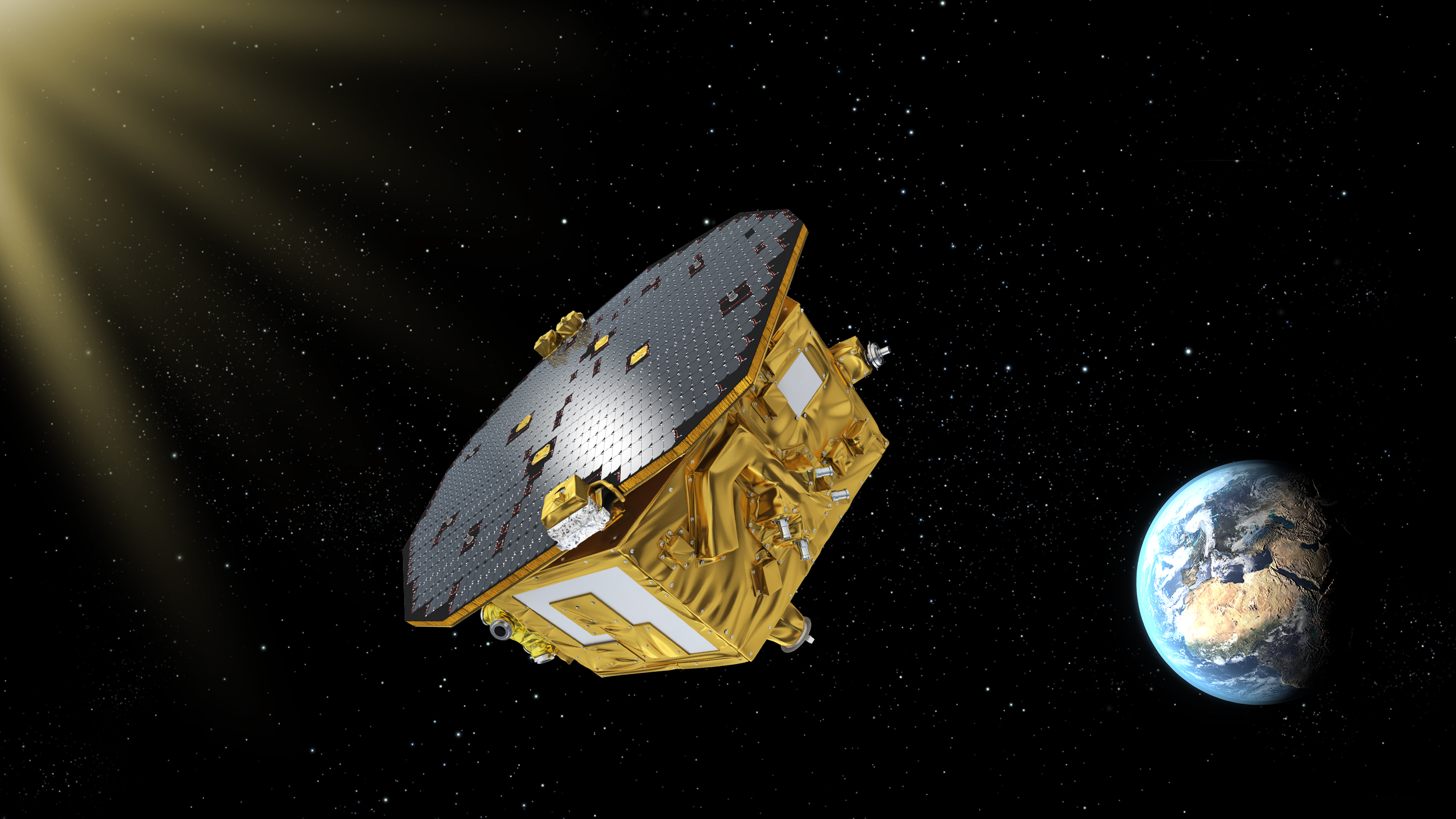
Whereas LIGO passes its laser beams through ultra-high vacuum tunnels 4 miles long, the proposed Laser Interferometer Space Antenna (LISA) will operate in the vacuum of space using three spacecraft whose orbits will maintain a triangular formation with sides 3 million miles in length. (ESA/C.Carreau)
Unfortunately, distant neutron star mergers probably do not produce gravitational waves sufficiently energetic for LIGO can detect. To overcome this limit, a further increase in the sensitivity of the interferometers will be implemented within the next few years. When LIGO finds its first neutron star merger, very likely Palomar’s wide-field telescope, the Samuel Oschin Telescope, will be called upon to find that event's electromagnetic aftermath.
A new window opens new ways of examining the Universe—we are likely to find that gravitational waves are produced by a variety of objects and conditions. Massive exploding stars may generate gravitational waves and so too may pulsars.
Indeed, one day it might be possible to detect and measure waves produced by gigantic cosmic strings that stretch across the Universe and are thought to have originated in the Big Bang. If LIGO and its planned successors—the space based LISA array, for one—are ever able to make such observations, we may then have the tools we need to open a window into the unification of the fundamental forces of nature and into quantum gravity.
Astronomical Interferometry at Palomar
By Andy Boden
Speaking as Steve is in these pages on LIGO (Laser Interferometer Gravitational-Wave Observatory) and the scientific implications for Palomar, the moment seemed opportune to consider previous Palomar interferometry efforts. Having mis-spent a significant fraction of my youth at Palomar working on the Palomar Testbed Interferometer (PTI—see below)...
Michelson’s Interferometer boom mounted on the Hooker Telescope at Mt. Wilson circa 1920. The boom is presently on display at Mt. Wilson. (Caltech Archives)
To frame my discussion I’ll begin by describing (if not exactly defining) the term interferometry as we use it in this edition of the newsletter. Interferometry is a scary-sounding word that literally means the measurement of the interference properties of something—in our case light—or more generally electromagnetic radiation. The light interfering at LIGO is from an internal laser, and interferometric “fringes” (the physical expression of the interference—variations in detected power as a function of the path difference in the two interferometer arms) is the observable proxy for the linear distances in the LIGO arms that change as a gravitational wave passes through the Observatory. It is a testament to the exquisite sensitivity of interferometric techniques that LIGO can measure distance changes through this observable proxy to a fractional precision of a few parts in 1016 (or 10,000,000,000,000,000—a number as difficult to imagine as the national debt!). LIGO interferometry does this apparent magic by taking advantage of the wave nature of light—specifically using laser light wavelength as its distance reference.
The concept of astronomical interferometry got its start at Mt. Wilson roughly 100 years ago in the experiments of Michelson and Pease, who measured the apparent diameters of dozens of stars (e.g. Betelgeuse) using an interferometric boom on the front of the Hooker Telescope. Astronomical interferometry is subtly different than what is practiced at LIGO; what is being measured is interference of the incident cosmic light (as collected by two or more distinct telescopes) with itself. Astronomers typically use interferometric techniques to economically access information on high angular resolution scales: Michelson et al would have needed a “filled-aperture” telescope larger than the Hale to resolve the apparent disk of Betelgeuse. But the affordable interferometric boom combined with the existing Hooker allowed Michelson to make measurements of the apparent size of Betelgeuse and other bright stars for a miniscule fraction of the cost of having to build a new, for-purpose telescope. Following Michelson, astronomers have successfully applied interferometric techniques in the optical, near-infrared, and particularly effectively in the radio (e.g. the ALMA array in Chile, and the Very Large Array near Socorro NM). Astronomers sometimes clumsily say that an interferometer with a large baseline (e.g. PTI below) is like having a telescope with that same size aperture. But that statement is not accurate. At best an interferometer collects only a fraction of the light and the information (in an information theoretic sense of the word) provided by a similarly sized filled-aperture telescope.
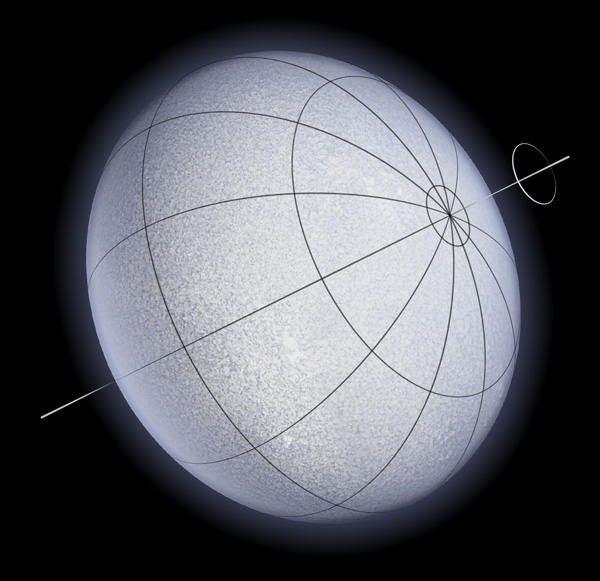
Artist’s conception of the rotationally-oblate Altair as measured by PTI in 2001. Altair’s rapid rotation causes the star’s geometry to deviate from spherical; its equatorial radius is roughly 14% larger than its polar radius. (Palomar/Caltech)
Roughly 60 years later, the late 1980s saw a renaissance in optical astronomical interferometry at Mt. Wilson and at Palomar. Mt. Wilson hosted a series of small-aperture stellar interferometers built and operated jointly by the Harvard Smithsonian Center for Astrophysics, MIT, the Naval Research Laboratory, and the US Naval Observatory. At roughly the same time, a team of astronomers and physicists from Caltech experimented with interferometric techniques on the Hale, using both “speckle” and non-redundant masking methodologies. [Aperture masking techniques have largely been superseded by modern adaptive optics technologies, which deliver similar data more efficiently.] A particularly important scientific result to emerge from these experiments was an early-1990s young star multiplicity survey conducted at the Hale by former Caltech graduate student (and current UCLA professor) Andrea Ghez. Ghez’s survey (and contemporaneous work in the Southern Hemisphere) established that young (“pre-main sequence”) stars are in multiple associations (binaries, triples, higher-order associations) significantly more frequently than older stars like our Sun. Ghez’s results are interpreted to indicate that multiplicity plays an important role in the star formation process, but many multiple systems disassociate as stars physically disperse from their natal environments.
By far the most ambitious interferometry project at Palomar was the Palomar Testbed Interferometer (PTI, Colavita et al 1998). PTI was constructed by a JPL-based team, and operated from 1995 to 2008. PTI operated in the near-infrared (1.6 – 2.2 μm), and its three separate 40-cm (16-in) collecting telescopes could be pair-wise combined to create baselines from 60 – 110 m (361 ft) in length. This combination of wavelength and baseline made the minimum PTI fringe spacing approximately 3 milliarcseconds (0.003 arcseconds) on the sky, and put PTI at the very forefront of high angular-resolution astronomy—similar in angular scale to VLBI techniques. At this fringe spacing PTI “resolved” essentially every naked-eye star in the Northern Hemisphere as an extended source.
PTI made numerous important astronomical contributions over the course of its lifetime (please see the references below for more information):
- First-of-a-kind direct observations of cepheid pulsations (Lane et al 2000), circumstellar material in pre-main sequence stars (Malbet et al 1998, Akeson et al 2000, Eisner et al 2004), and rotationally-oblate stellar profiles (van Belle et al 2001).
- High-precision stellar calibrations through physical modeling of binary stars (e.g. Boden et al 1999, 2000, 2001, 2005, 2006; Konacki et al 2004, 2010; Pan et al 2004)
- Stellar angular diameter/effective temperature calibrations (e.g. van Belle et al 1999, Lane et al 2001).
- High-precision narrow-angle differential astrometry using unique dual-beam interferometry techniques (Lane et al 2000; Muterspaugh et al 2006, 2008, 2010).
PTI development and operations set the stage for the NASA’s Keck Interferometer, and strong collaborations between PTI programs and ongoing research in the CHARA and NPOI interferometer communities have kept PTI results relevant today. Even though PTI has been decommissioned for nearly a decade, its scientific and technical legacy remains relevant in today’s astronomy landscape.
Upcoming Events
On Saturday, July 22, David Reitze, Executive Director of the Laser Interferometer Gravitational-wave Observatory (LIGO) based at Caltech will speak on the subject of “Black Holes Last Tango in Space: LIGO and the Dawn of Gravitational-wave Astronomy.”
Dr. Reitze received his Ph.D. from the University of Texas at Austin in 1990. His research has focused on ultrafast optics and lasers and the development of high-power optical components. He led the design effort for the input optics of Advanced LIGO before becoming the project's executive director.
David Reitze announces the detection of gravitational waves on February 11, 2016. (Euronews)
On February 11, 2016, Dr. Reitze and his colleagues announced to the world the first direct detection of gravitational waves.
On July 22, our evening will get started at 6:30 pm with a reception and light refreshments at the Outreach Center. An RSVP would be appreciated and family members are welcome. Dr. Reitze will begin his presentation at 7:00 pm and afterwards the docents will hold a star party on the basketball court behind the Outreach Center.
We also anticipate scheduling a Friends event in the fall. I will send an update when plans are more fully settled.
In addition, we will be holding another Saturday afternoon cookout at the Outreach Center sometime in late September or early October. Burgers and hot dogs and salad and popcorn and a movie—all the Friends of Palomar Observatory are invited and I’ll send an announcement.
- Steve Flanders
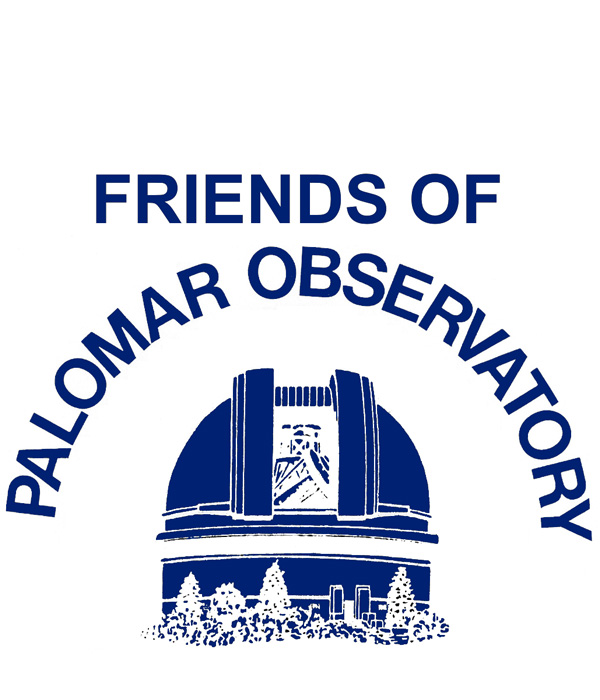
Questions? We've answered many common visiting, media, and academic questions in our public FAQ page.
Please share your feedback on this page at the
COO Feedback portal.
Big Eye 12-2
Last updated: 02 February 2021 SBF/AFB/ACM

